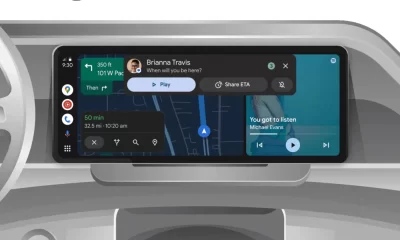Google Photos introduces ‘Updates’ Feed; YouTube for Android TV adds quick ‘Subscribe’ button to improve user experience

In recent updates, Google Photos and YouTube for Android TV have each introduced new features aimed at enhancing user convenience and interaction. Google Photos has shifted from the former “Sharing” tab to a new “Updates” feed, while YouTube for Android TV has added a more accessible “Subscribe” button within its player interface.
Google Photos’ New ‘Updates’ Feed
Following the August switch from a “Library” to a “Collections” tab, Google Photos has now replaced its “Sharing” tab with an “Updates” feed. Previously, the “Sharing” page featured a “people” icon situated between the ‘plus’ menu and the profile icon. Users could access shortcuts like “Create shared album” and “Share with partner,” followed by an “Albums and Memories” carousel and a list of “Conversations” at the bottom.
Now, this layout has been restructured. A notification bell icon in the app bar indicates sharing activity and directs users to the new “Updates” feed. This feed organizes recent sharing actions, including shared links and conversations, streamlining the view of shared moments and memories. The overflow menu also provides direct access to:
- Sharing activity: Track shared links, shared memories, and ongoing conversations.
- Conversations: View shared discussions in one place.
This change reflects a move away from the in-app messaging function, “Conversations,” aligning with Google’s common UI pattern of a notification bell, seen across apps like Google Home, Play Store, and YouTube. Currently, the “Updates” feed rollout is available for Google Photos on Android, though not yet on iOS.
YouTube for Android TV Adds Prominent ‘Subscribe’ Button
YouTube on Android TV has introduced a more visible “Subscribe” button directly within the main player interface, allowing users to easily subscribe to channels without needing to exit the video. The Android TV version of YouTube has evolved over the past few years, adopting a dual-column layout and larger visuals designed for TV screens. These adjustments allow easier navigation with a remote instead of a touchscreen or mouse.
In this latest change, users watching a channel they aren’t subscribed to will now see a prominent “Subscribe” button within the player UI. This quick-access feature lets users instantly join channels they find interesting or valuable without multiple steps. For those already subscribed, the button won’t appear, keeping the layout cleaner for regular viewers.
Additionally, the “Like” and “Dislike” buttons, previously combined, have returned to individual icons, adding more control options within the interface. Though this may make the UI appear somewhat crowded, it serves to encourage users to subscribe while also improving their content interaction options.
These changes across Google Photos and YouTube for Android TV are part of Google’s broader strategy to streamline user interaction and engagement across its ecosystem, offering convenient and quick-access tools in both mobile and TV settings.
Android
Google updates Gboard emoji kitchen and Android Auto with new features

Google is bringing some fresh updates to make Gboard and Android Auto even better.
Starting with Gboard, the Emoji Kitchen now has a new “Browse” section. This makes it easier for users to find different emoji sticker combos. You can tap on any emoji and instantly see all the creative mixes available. Plus, there’s a search bar to help you look for specific stickers. This new feature is rolling out first to Pixel devices, with other Android phones expected to get it in the coming months.
On the other hand, Android Auto is now getting the 14.3 beta update. Although there are no big changes yet, this version mainly focuses on fixing bugs and improving performance. Testers have noticed slight speed improvements, but no new features have been spotted so far. Google might be preparing for bigger changes in future updates.
Both these updates show that Google is working hard to make its apps smoother and easier to use. Gboard’s new browsing tool will make messaging more fun, while Android Auto’s small fixes are important for a better driving experience.
If you have a Pixel phone or are part of the Android Auto beta program, you might already see these updates. Otherwise, they should be available to more users soon.
Android
Android’s Find My Device speeds up with UWB coming soon

Google’s Find My Device network for Android has gotten a big boost, making it much quicker to locate misplaced items. Recent checks show it’s now four times faster than it used to be, keeping up with Apple’s AirTags in crowded spots like malls or events. For instance, at CES 2025, a tracker tucked in a bag updated its location just as fast as an AirTag nearby. This speed-up is thanks to more Android users turning on tracking for all locations, not only busy areas, which helps the system spot items more reliably.
In less crowded places, the network can still have trouble since fewer Android phones are nearby to share location signals. But Google’s working on this by nudging users through app alerts to enable tracking in quieter spots. Plus, recent updates to tracker software and apps have made connections more stable and accurate.
Looking ahead, Google’s gearing up to roll out ultra-wideband (UWB) technology. This will let you find items with pinpoint accuracy, even within a room, using cool augmented reality (AR) visuals, much like Apple’s setup. The Moto Tag, a tracker ready for UWB, is already available, just waiting for Google to activate this feature. Not all Android phones support UWB yet, but future models like the Pixel 10 might include it. These changes prove Google’s determined to make its Find My Device network a top choice for tracking lost stuff.
Gmail and Google Photos get new design and useful updates

Google is giving Gmail and Google Photos some fresh updates to make things easier and more user-friendly.
First, Gmail on the web is now getting a new layout option. You can choose between “Cozy,” “Comfortable,” or “Compact” views based on how much space you want between your emails. Google is also adding a setting to control whether your inbox and labels stay on screen or only show up when needed. These changes make it easier to personalize how Gmail looks and feels.
Meanwhile, Gmail for iPhone is getting a visual upgrade. The app now uses Google’s updated design style called “Material 3.” You’ll notice a cleaner look with a rounded search bar at the top, smoother icons, and better spacing. Although the bottom bar and buttons look mostly the same, the overall design feels more modern and easier on the eyes.
Lastly, Google Photos is bringing back a helpful feature. The classic search shortcut that appears in the bottom bar is returning, making it quicker to find your photos. Before this, the shortcut had been removed when Google added the new “Memories” tab. Now, both features work together, letting you browse memories and search with ease.
These updates aim to make Google’s apps feel more useful, clean, and easier to use on both desktop and mobile.
-

 Apps1 year ago
Apps1 year agoGboard Proofread feature will support selected text
-

 News1 year ago
News1 year agoSamsung USA crafting One UI 6.1.1
-

 News1 year ago
News1 year agoBreaking: Samsung Galaxy S22 may get Galaxy AI features
-

 News1 year ago
News1 year agoSamsung Galaxy S23 Ultra with One UI 6.1 and all S24 AI features revealed
-

 News1 year ago
News1 year agoOne UI 6.1 Auracast (Bluetooth LE Audio) feature coming to many Samsung phones
-

 News1 year ago
News1 year agoSatellite SOS feature coming to Google Pixel phones, evidence leaked
-

 Apps11 months ago
Apps11 months agoGoogle’s fancy new Weather app is finally available for more Android phones
-

 News1 year ago
News1 year agoGoogle Pixel evolves as Europe’s third best selling flagship












